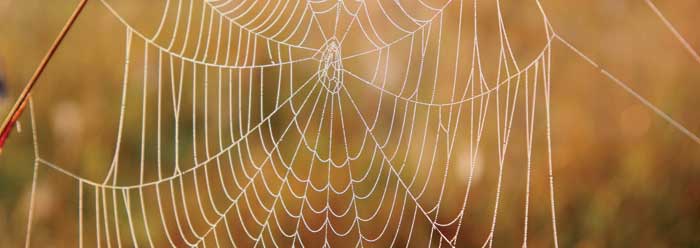Garden spider webs look amazing, but they also are so strong that they inspire materials scientists. Research recently showed that spider webs actually strengthen after they are slightly damaged. Experiment results demonstrated that too much damage did eventually weaken the webs, but not before they withstood hurricane force winds and multiple breaks. How did spider webs get so well-engineered?
Spider silk is stronger than steel and tougher than Kevlar pound-for-pound, but the overall web that garden spiders weave is even stronger than its silk proteins. In a report published in Nature, researchers wrote, “Spider webs themselves are characterized by a highly organized geometry that optimizes their function.”1 The team tested the behavior both of radial threads and spiral threads in order to discover secrets of web geometry. Like spokes on a bicycle wheel, the radial threads anchor to nearby objects. The spiral threads crisscross and anchor to the radial threads.
This Nature study found that a spider silk strand resists stress in a stepwise fashion. After initially stiffening, the thread absorbed stress by stretching. Additional pressure caused the thread to sharply stiffen, thus transferring pressure to the rest of the web. But even more pressure was handled by a fourth and final process. Crystalline structures within the spider silk protein absorbed the maximum strain and broke, leaving the larger web intact. For example, a struggling insect would not break the whole web, but only those silk strands in contact with the insect. And after a local thread or two broke, the overall web strength increased! The study authors wrote that “the ultimate load capacity increased by 3-10% with the introduction of defects.”1 It’s as though the web was designed to anticipate breaks.
If the entire web broke apart because of stress applied in just one area, then the spider would have to recast a new web each time it broke, creating a monumental workload: “Given the presumed metabolic effort required by the spider for rebuilding an entire web, localized failure is preferential as it does not compromise the structural integrity of the web and hence allows it to continue to function for prey capture in spite of the damage.”1 Because their webs remain stable after damage, spiders simply repair them. The superior engineering in both material and structural layout enables spiders to catch multiple meals with the same web.
Scientists cannot make the raw materials of silk with man-made machinery, but have used genetically modified bacteria and goats to manufacture silk proteins.2 So far, only a spider’s silk glands and spinnerets can assemble the world’s most resilient biodegradable thread. But engineers recognize the benefits of copying the design features of the spider web architecture as well as the webbing strands.
The “engineering design could ignore the requirements for the magnitude of a potential load and allow local failure to occur, a design stipulation that requires the consideration of both material and structural architecture.”1 For example, automobile designers incorporate built-in crumple zones where “local failure” absorbs the force from a head-on collision instead of the driver’s body.
The Nature study authors called spider webs an “optimized” system, meaning that the design could not be improved.1 Did nature optimize spider webs, or did the Creator optimize them? Experiments do not show nature optimizing biological structures. In fact, undirected nature breaks down structures. Of these two origins options, only one is an actual person—an Engineer and more, with real thoughts, who is capable of the consideration required to create spider webs.3
References
- Cranford, S.W. et al. 2012. Nonlinear material behaviour of spider silk yields robust webs. Nature. 482 (7383): 72-76.
- Xia, X-X et al. 2010. Native-sized recombinant spider silk protein produced in metabolically engineered Escherichia coli results in a strong fiber. Proceedings of the National Academy of Sciences. 107 (32): 14059-14063.
- “The counsel of the LORD standeth for ever, the thoughts of his heart to all generations” (Psalm 33:11).
Image credit: © Mikhail Kokhanchikov | Dreamstime.com
* Mr. Thomas is Science Writer at the Institute for Creation Research.
Cite this article: Thomas, B. 2012. The Masterful Design of Spider Webs. Acts & Facts. 41 (4): 16.



















